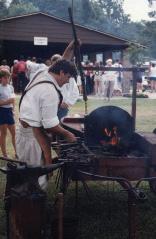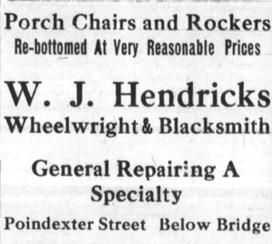
2 minute read
Wheelwrights, Wagon Wranglers, & Welders
by Paul Vincent, Contributing Researcher
When you hear the word blacksmith , what images come to mind? Do you think of the red-orange glow of heated metal? Perhaps you see a deluge of hot sparks? Or do you hear the rhythmic clank-clink-clank of hammer hitting an anvil?
The village smithy of yore, hard at work by a sweltering forge, hammering away on a robust piece of iron, is part and parcel of Museum of the Albemarle’s latest small exhibit, Wheelwrights, Wagon Wranglers, and Welders: Blacksmithing in the Albemarle
BLACKSMITHING DEMONSTRATION AT FORT RALEIGH, 1984

Blacksmithing has survived and evolved in the Albemarle since the first English colonists arrived on Roanoke Island.
Courtesy Museum of the Albemarle
Wheelwrights, Wagon Wranglers, and Welders highlights the role of blacksmiths in our American society—as well as our local communities here in the Albemarle—by tracing the evolution of this trade and the wide range of skills its practitioners possess. Blacksmiths leading up to the horseand-buggy era were not only metal workers, but often horseshoers, coach builders, and all-around tinkerers. During the 20th century, blacksmithing grew to incorporate intricate knowledge of machining and welding, skills that continue to be used by the smithies of today.
ADVERTISEMENT FOR W. J. HENDRICK’S WHEELWRIGHT & BLACKSMITH SHOP, 1916

As evidenced by this advertisement, blacksmiths usually maintained a diverse skillset and could repair, as well as fabricate, various tools and implements.
Courtesy The Advance
We invite you to learn more about these people, their handmade implements, and the tools related to the blacksmithing trade with a visit to Wheelwrights, Wagon Wranglers, and Welders , now on view at Museum of the Albemarle.










